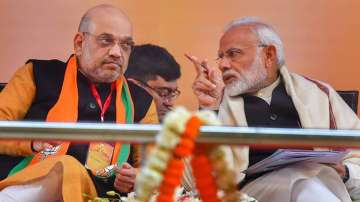The Bharatiya Janata Party (BJP) today is a dominant political force in the country, credit to its growing acceptance among the public across the length and breadth of India. The BJP won 282 seats in 2014 and retained power in 2019 by winning 303 seats -- securing absolute majority on both the occasions and also putting an end to the coalition era.
Since then, the 'Lotus' is blooming in every nook and corner of the country. The emerging dominance of the BJP under Narendra Modi and Amit Shah's leadership has given sleepless nights to the Congress that ruled for 60 years after Independence. Such is the situation that there has been no effective opposition in the country in the last 8 years.
From just two seats in Lok Sabha in 1984 to winning two back-to-back majority in general elections and in Assembly elections in Uttar Pradesh, the party has been an election-winning cavalry since 2014. Its right-wing Hindutva ideology has firmly taken the centre-stage of the country's political landscape, displacing the Congress. Although the party lost some (Delhi, Punjab, Rajasthan), it has a strong presence in almost every state, covering 17 states and one UT.
BJP's strong organisational set up
Post-2014, the BJP under Modi-Shah has written new success stories for both -- the party and the nation. From winning general elections to scrapping Article 370 and making the BJP world's largest political party, the saffron party has given decisive leadership to 135 crore Indians. The loss in Madhya Pradesh, Rajasthan and Chhattisgarh in 2018 triggered talks about whether the BJP's downward trend has started. The Karnataka story too was interesting and saw Opposition leaders coming together to keep the BJP away from power. But the party's groundwork and its organisational strength posed a threat to the Congress government in Madhya Pradesh and Congress-JD(S) government in Karnataka, prompting it to return to power.
After its 2019 sweep, the BJP shifted its focus towards West Bengal and emerged as the principal opponent to the TMC by replacing the Left and Congress. The party did lose Jharkhand to the Congress-JMM-RJD but it was not a setback. In Haryana, it fell short of a majority but managed to cross the halfway mark with the support of JJP. The party performed well in Maharashtra election to win but lost because ally Shiv Sena walked away.
In the North East, there was a time when the Congress was a major political force. But the BJP's outreach programme, strong cadre and connection with the people helped it to replace the grand old party. The BJP directly or through the NDA is ruling all the seven NE states (Assam, Arunachal Pradesh, Manipur, Meghalaya, Mizoram, Nagaland, Sikkin and Tripura).
The BJP's rising political graph and acceptance of its ideology in the country under Modi-Shah leadership has stumped the political pundits who never imagined that the BJP would be able to travel this far when it came into existence on April 6, 1980.
READ MORE: From 2 seats in 1984 to ruling 17 states - The story of BJP's meteoric rise
Latest India News
